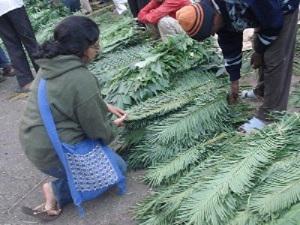Vandana Krishnamurthy
This project aims at getting a worm’s-eye view about the use, status and responses of Cycas species in the Western Ghats. For this I will obtain the necessary data to ensure effective conservation through research on trade, ethnobotany, life history and population dynamics.

Historical records reveal a rich tapestry of interactions between cycads and humans all over the world. These records indicate use of cycads in local ceremonies, food, as well as for magical and medicinal purposes. However, around the 20th century cycad use changed dramatically entering into an exploitative phase of market trade mainly for ornamental value. Apart from this, plant products like seeds and pith for food and medicine have also made their way into regional markets in the past few years. As a consequence of this harvest, about 82% of all cycads are listed as “threatened” by the IUCN. In response to the worldwide threats to cycads, all cycad species have been listed in the Convention in International Trade in Endangered Species of Wild Fauna and Flora (CITES).
In southern India, species of the genus Cycas (C. circinalis L. and C. indica Lindstrom & Hill) are highly harvested from the Western Ghats by indigenous communities and commercial harvesters. Indigenous people have been using the leaves, seeds and bark of Cycas spp for cultural, food, and medicinal purposes for many generations. However, the lucrative market drives harvesters to exploit Cycas spp for commercial sale, where cones, leaves, pith, and seed are customarily executed in bulk for food, medicinal and floricultural purposes. FRLHT estimated a reduction in C. circinalis populations of > 80% and >50% in the states of Karnataka and Tamil Nadu respectively. Plant products are collected en masse often lopping whole plants especially in the case of pith harvest. Harvest is relatively effortless as most cycad populations are found in clumps, minimizing the amount of time spent looking for the plant. The legalities of harvest vary over the range of Cycas spp; albeit, most harvest is done illegally. It is evident that pressure from harvest is immense. However, little is known about the quantity, rate and seasonality of harvest of these plant products.
Cycas spp have ancient lineages from the Jurassic age, being long-lived and slow-growing, and this coupled with intensive extraction reduces the chances for populations to rapidly revive themselves after the induced stress of harvest. In an attempt to understand the uses and responses of these species to harvest pressures, this study aims to document the trade, ethnobotany, life history, and population dynamics of Cycas spp. A detailed understanding of trade patterns and of the factors affecting population dynamics in different harvest and habitat types is critical to implement protection of these species.